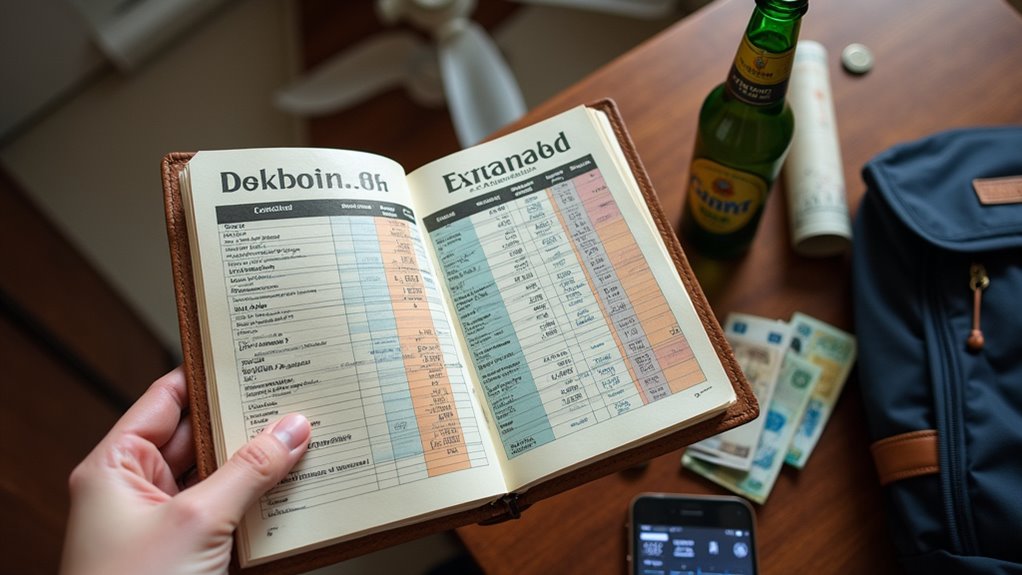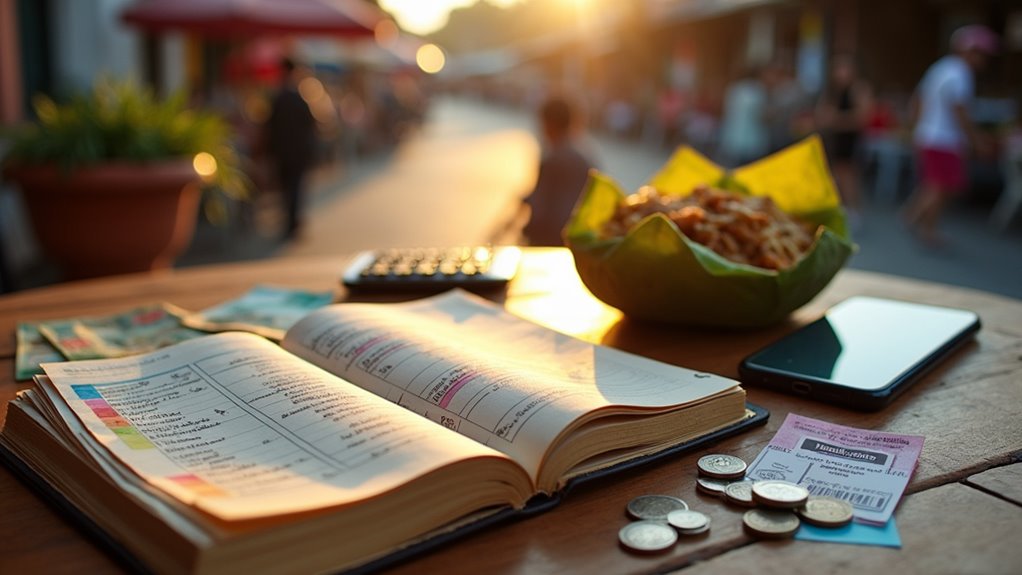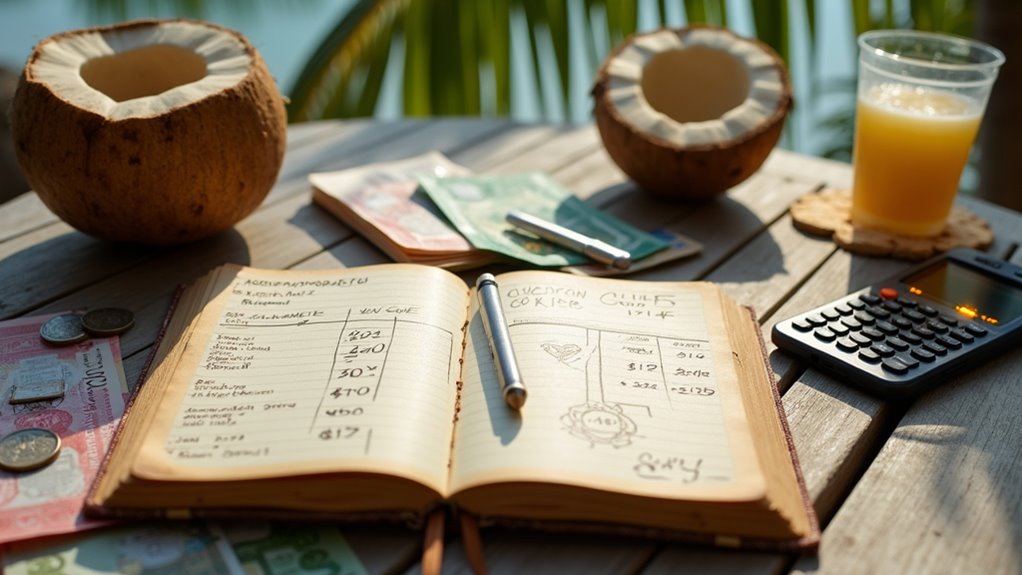Physical Address
304 North Cardinal St.
Dorchester Center, MA 02124
Physical Address
304 North Cardinal St.
Dorchester Center, MA 02124

Get the inside scoop on Thailand's monthly costs, from budget-friendly ฿15,000 to luxury ฿60,000—your wallet depends on it.
You’ll need ฿15,000-60,000 ($430-1,700) for a month in Thailand, depending on your travel style. Budget travelers can thrive on ฿15,000-20,000 with hostels (฿200-400/night) and street food (฿30-100/dish), while mid-range travelers spend ฿30,000-40,000 on private rooms and occasional restaurants. Prices jump 20-30% during peak season (December-February), so consider visiting during shoulder seasons for better deals. The right planning strategies will stretch your baht much further.

When planning your Thailand adventure, understanding how different travel styles impact your budget is essential.
Budget travelers can manage with ฿15,000-20,000 monthly, staying in shared accommodations and enjoying street food (฿45-200 per meal).
Mid-range travelers should budget ฿30,000-40,000, affording private rooms, occasional restaurant dining (฿500-2,000 for two), and more entertainment options like movies (฿140-600) and nightlife experiences.
Luxury travelers will need ฿60,000+, covering high-end condos, fine dining (฿3,900+ per person), and premium entertainment. Health-conscious travelers should know that quality healthcare is accessible with health insurance plans starting around ฿12,000 annually.
Regardless of your style, transportation remains affordable with options from public transit to taxis.
Consider signing longer leases for housing discounts and utilizing local markets for groceries to stretch your budget further.
Taking advantage of local travel deals can significantly reduce costs when exploring different regions of Thailand during your month-long stay.
Finding the right place to stay in Thailand can dramatically impact both your experience and budget. Hostels offer the best value with dorm beds at $6-12 nightly, including Wi-Fi, lockers, and communal kitchens—plus built-in social opportunities through organized tours and pub crawls.
For more privacy, consider:
Location matters—central Bangkok accommodations cost 15-20% more than suburban options, while Chiang Mai hotels run about 30% cheaper than equivalent Bangkok properties. For unbeatable value in Chiang Mai, the Bed Phrasingh hotel offers modern, comfortable rooms with included breakfast at budget-friendly rates. When choosing accommodations, prioritize properties with good security measures to ensure your personal safety throughout your stay in Thailand.
Remember that prices everywhere increase 20-30% during peak season (December-February), so timing your visit strategically delivers significant savings.

Thailand’s culinary scene offers one of the best value propositions for travelers, with options spanning from humble street carts to luxurious restaurants. You’ll find incredible street food for just 30-100 THB per dish, making a 300 THB daily food budget entirely feasible.
For ideal budgeting, allocate 70% to street food, 25% to mid-range dining (150-500 THB per meal), and 5% to occasional upscale experiences (600+ THB).
Start days with street breakfasts under 50 THB to maximize savings.
Visit night markets for best portions at lowest prices and avoid beachfront tourist zones that charge 2-3x premiums. The Ratchada Train Night Market in Bangkok features exceptional grilled seafood and desserts at budget-friendly prices.
Don’t miss sampling authentic Thai dishes during your travels, with popular options ranging from spicy curries to flavorful noodle dishes.
Northern Thai dishes typically cost less than seafood-heavy southern fare. Remember that alcohol, especially wine, considerably increases your bill at any hotel.
Exploring Thailand’s diverse transportation landscape presents one of the best opportunities to stretch your travel budget while experiencing the country authentically. With BTS Skytrain fares between 15-62 baht and MRT rides costing 17-43 baht, urban travel remains incredibly affordable.
Thailand’s budget-friendly transit options offer authentic experiences without breaking the bank.
The extended 20-baht flat fare on SRT Red and MRT Purple lines until November 2025 offers even better value. Thailand’s transport system is undergoing major improvements with a target launch date of September 2025 for the nationwide 20 baht flat fare program. When planning your itinerary, consider whether you prefer the mountainous tranquility of Chiang Mai or the coastal beauty of Phuket, as this will impact your transportation needs.
Using travel cards in Bangkok and planning routes carefully will maximize your transportation budget while giving you authentic local experiences.

From temples to treks, Thailand’s attractions offer incredible value at every price point. Budget travelers can spend just $5-15 daily enjoying temple visits (Wat Phra Kaew: 500 THB) and free beaches.
While mid-range travelers might allocate $20-40 for cooking classes or national park entry fees.
Luxury experiences like private island tours or VIP diving packages start around $60 daily.
Cultural attractions remain affordable with major temples costing 50-500 THB and many museums offering free entry.
Adventure enthusiasts can find diving certifications on Koh Tao (9,000-12,000 THB) or jungle treks in Khao Sok (1,200-3,500 THB).
Popular day trips include the Phi Phi Islands tour from Phuket for approximately 1,850 THB per person.
To maximize your budget, prioritize free attractions, negotiate group discounts, use combo tickets, and always set aside 10-15% for spontaneous experiences.
The average traveler spends about $21 daily on activities.
Make sure to check your visa duration limits when planning your activities to ensure you have enough time to experience everything Thailand has to offer.
Timing your visit strategically can dramatically impact your Thailand budget. Peak season (December-February) inflates costs by 30-50%, with budget guesthouses jumping from ฿500 to ฿1,800 nightly and minimum stay requirements during holidays.

Savvy travelers can slash their Thailand expenses by 40-60% through strategic choices and avoiding common traps that drain budgets. Stay in hostel dorms or guesthouses instead of luxury hotels, and enjoy $1.50 Pad Thai from street vendors rather than tourist restaurants.
You’ll save markedly by using public transportation—buses and overnight trains cost a fraction of taxis or rentals. Prioritize free temple visits and hiking over expensive guided tours, and track your spending using budget apps to maintain your daily allowance. Independent travelers typically spend around 35 THB daily when following a strict budget approach. When planning your trip, consider that Chiang Mai offers significantly lower costs for accommodation and activities compared to Bangkok.
Watch out for common pitfalls: overpriced tours, luxury splurges, and impulse shopping in tourist areas. Excessive drinking quickly depletes funds, while lack of planning leads to emergency spending. Exchange currency at local services rather than airports, and always seek advice from locals about affordable hidden gems.
Your month in Thailand can be as frugal as $600 or as lavish as $3,000 depending on your choices. Like a skilled chef balancing flavors, you’ll need to mix budget accommodations with occasional splurges. Plan wisely, eat locally, use public transport, and watch for seasonal price hikes. With these strategies, you’ll stretch your baht further while creating priceless memories in the Land of Smiles.